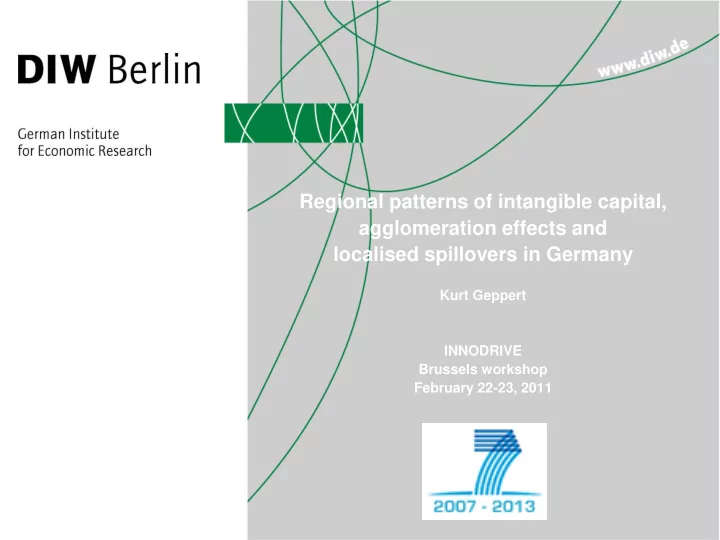

Regional patterns of intangible capital, agglomeration effects and localised spillovers in Germany Kurt Geppert INNODRIVE Brussels workshop February 22-23, 2011
Data The dataset used for this analysis provides information on … … establishments, not firms … self -produced intangible assets calculated on the basis of expenditures … the period from 1999 to 2003 INNODRIVE Brussels workshop February 22-23, 2011
Steps of the analysis Distribution of self- produced intangible capital across … … establishments … industries … regions Intangible capital and the wage level of establishments – micro data analysis Conclusions INNODRIVE Brussels workshop February 22-23, 2011
Establishments Share of intangible capital in total capital by establishment size 25 20 15 10 5 0 1-9 10-49 50-99 >=100 Sizeclass (employees) INNODRIVE Brussels workshop February 22-23, 2011
Industries Intangible capital per hour worked Components of intangible capital Euros 100 % 25 90 % 80 % 20 70 % 60 % 15 50 % 40 % 10 30 % 20 % 5 10 % 0 % Production Transport and Trade and business services consumer services 0 Production Transport and Trade and business services consumer services Org. capital R&D capital ICT capital INNODRIVE Brussels workshop February 22-23, 2011
Regions Shares of regions in national intangible capital Intangible capital per hour worked 2003 2003 INNODRIVE Brussels workshop February 22-23, 2011
Regions Growth of regional value added 1999 - 2003 Regional value added per hour worked 2003 45 35 Frankfurt Hamburg 43 Growth of value added 1999 - 2003 in % 30 Value added per hour worked 2003 R² = 0.2319 41 25 39 20 37 15 35 10 33 5 31 0 29 -5 27 R² = 0.8012 25 -10 0 5 10 15 20 25 0 5 10 15 20 25 Intangible capital intensity 2003 Intangible capital intensity 1999 INNODRIVE Brussels workshop February 22-23, 2011
Intangible capital and the wage level of establishments Dependent variable: log average hourly wage of establishments. Period of observation: 1999-2003 Fixed Random OLS effects effects Non- All employees intangible All employees employees (1) (2) (3) (4) (5) Establishment variables 0.0108 *** 0.0116 *** 0.0141 *** -0.0046 *** 0.0053 *** Employment 0.0103 *** 0.0103 *** 0.0097 *** 0.0015 ** 0.0087 *** Intangible capital intensity 0.0594 *** 0.0566 *** 0.0583 *** 0.0149 *** 0.0187 *** Tangible capital intensity Economic environment Own-industry: 0.0064 *** 0.0064 *** 0.0021 *** Number of Establishments 0.0003 0.0013 *** 0.0012 *** 0.0004 * Intangible capital intensity 0.0000 Rest of regional economy: 0.0267 *** 0.0268 *** 0.0067 *** Industrial diversity -0.0021 0.0833 *** 0.0828 *** -0.0180 *** 0.0197 *** Intangible capital intensity Settlement type: 0.1190 *** Large Metro 0.0335 *** Small Metro 0.0234 *** Intermediate region -0.226 *** -0.180 *** -0.182 *** -0.201 *** East dummy 2.394 *** 2.127 *** 2.111 *** 3.023 *** 2.498 *** Constant N 150471 150471 149779 150471 150471 R-squared 0.684 0.683 0.660 0.459 0.662 Number of establishments 41156 41156 INNODRIVE Brussels workshop *** p<0.01, ** p<0.05, * p<0.1 (robust standard errors); variables in logarithms; 3-digit industry dummies. February 22-23, 2011
Conclusions Intangible capital accounts for more than 20 % of total capital in the non-farm private economy R&D capital is the largest component of intangible capital – at least in Germany Intangible capital is positively related to the economic performance of regions Self-produced intangible capital of establishments has a positive effect on productivity and wages – both for “intangible” and “non - intangible” workers There are sizable externalities of agglomeration: establishments in large metro areas pay 12 % more than those in rural regions Externalities across industries (urbanisation effects) appear to be more important than externalities within industries (localisation effects) With our dataset we can not satisfyingly tackle estimation problems resulting from spatial selection, unobserved characteristics and endogeneity … … but our findings indicate that there are significant positive relationships between intangible capital, productivity of establishments, and regional economic performance – and that intra-regional externalities play a role in these processes INNODRIVE Brussels workshop February 22-23, 2011
Recommend
More recommend